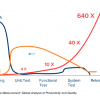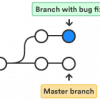 |
The Shift-Left Approach to Software Testing The earlier you find out about problems in your code, the less impact they have and the less it costs to remediate them. Therefore, it's helpful to move testing activities earlier in the software development lifecycle—shifting it left in the process timeline. This article explores the shift-left methodology and how you can approach shifting left in your organization. |
|
 |
Picking the Right Branch-Merge Strategy A good branch-merge strategy facilitates processes among multiple developers and is the basis for any well-functioning DevOps pipeline that uses continuous integration. Let’s explore branching strategies, merging strategies, and how you can put them together in a way that’s right for your team in order to bring quality features to production faster. |
|
 |
Testing a Software Rewrite Suppose we’re looking at a system rewrite where the stakeholders have none of the original engineering documentation. (This isn't surprising; documentation becomes obsolete—or even misleading—as the system changes, and corresponding docs don't get updated.) What can we do? Here are some tactics to use—and risks to anticipate—when testing a system rewrite. |
|
 |
Why You Need Continuous Testing in DevOps DevOps is more than adopting the right set of tools; it's a cultural shift that incorporates testing at each stage of the agile project lifecycle. Continuous testing is key to unlocking this culture change because it weaves testing activities into every part of the software design, development, and deployment processes, which helps everyone involved communicate more, collaborate better, and innovate faster. |
|
 |
When DevOps Gets Lost in Translation The waterfall method of developing software is a bunch of translation activities: The design is a translation of the requirements into the language of architecture, the code is another, and a formal test process is a third. And with each translation, there’s the opportunity to introduce error. When your DevOps team is isolated, it creates another handoff, and another point of failure. |
|
 |
4 Keys to Protecting Your Data in a DevOps World It may seem like the desires for end-to-end DevOps and protection of sensitive data are in conflict, but if done correctly, they can be two sides of the same coin. DevOps processes such as version control and delivery automation introduce the very measures needed to properly protect production data. The key to keeping data safe while using it during your DevOps process is to focus on these four areas. |
|
 |
Shifting Testing Left Bakes In Quality from the Start “Shift left” is one of the latest buzz terms in software testing. Movements like agile and DevOps recommend that testers shift left, but what does that mean, exactly? Here's how one tester became a believer in the shift-left movement; how he got his team's developers, analysts, designers, and managers on board; and how his entire organization has benefited from the shift. |
|
 |
5 Ways to Optimize Tests for Continuous Integration Many teams have existing automated test suites that are not included in a continuous integration program. Maybe the tests take too long to execute, or they are not reliable enough to give accurate results. Here’s how to assess your test suites in terms of value added and time to execute, along with five proven strategies to optimize those suites for CI. |
|
 |
Measuring the Performance of Your Operations Center Many organizations have problems with consistently tracking and measuring system outages. Issues aren't logged, admins make changes to systems without going through change management, and a high number of issues turn out to be recurring problems. Implementing a performance measurement process calculates system reliability and can help you improve consistency. |
|
 |
Shifting Testing Left Is a Team Effort There is a lot of talk in the testing world about shifting left. Basically, “shift left” refers to moving the test process to an earlier point in the development process, independent of the development approach. This article explores a case in which shift-left has been applied, and the lesson is that shifting left cannot be achieved by testers alone—it must result from a team effort. |
Pages
Upcoming Events
| Jun 02 |
AI Con USA Bridging Minds and Machines |
| Sep 22 |
STARWEST Software Testing Conference in Anaheim & Online |
| Oct 13 |
Agile + DevOps USA The Conference for Agile and DevOps Professionals |












